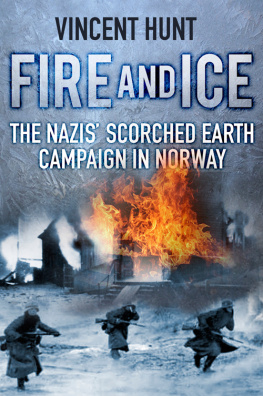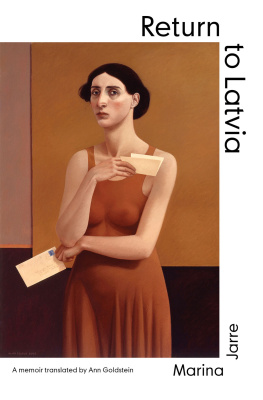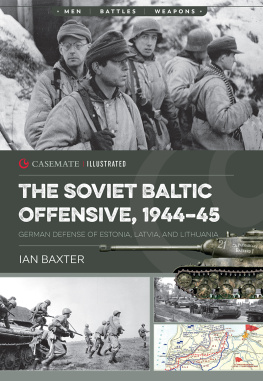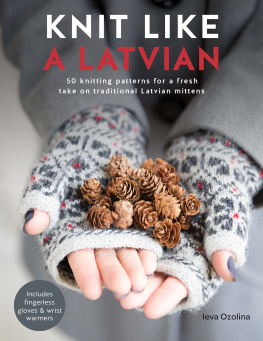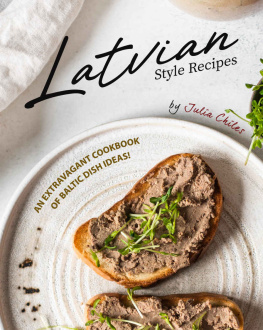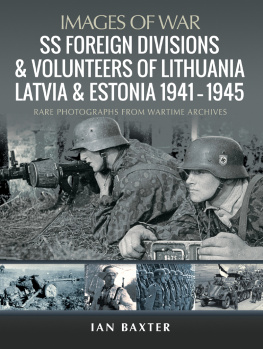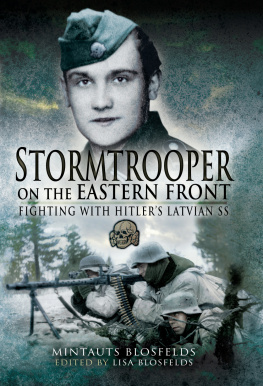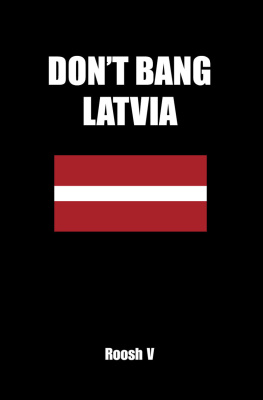Pagebreaks of the print version

BLOOD IN THE FOREST
he Shores of Kurland (Kurzemes krasts)
By Veronika Strlerte
Dimly and vaguely there came into vision
Blurred ship masts, phantom-like frames,
Twilight unbroken stretched endless and vast;
Suddenly sorrow they broke overcast:
Kurzeme, distant, appeared amidst flames.
There it remained, land of hopes, of our freedom,
Of glory and creed a shattered shrine.
Thou that in exile risest and sleepest
Carry, when foreign darkness is deepest,
Firmly engraved this fiery sign.
Ringing of bells has brought peace to nations.
Is there a bell that for us proclaims?
On all the crossroads and fateful turnings
We feel in thirst and smoke-choked yearnings;
Kurzeme beckons to us through flames.
This book is dedicated to Jnis Kamerads of Jaunpiebalga.
BLOOD IN THE FOREST
The End of the Second World War in the Courland Pocket
Vincent Hunt
Helion & Company Limited
26 Willow Road
Solihull
West Midlands
B91 1UE
England
Tel. 0121 705 3393
Fax 0121 711 4075
Email:
Website: www.helion.co.uk
Twitter: @helionbooks
Visit our blog at http://blog.helion.co.uk/
Published by Helion & Company 2017
Designed and typeset by Mach 3 Solutions Ltd ( www.mach3solutions.co.uk )
Cover designed by Paul Hewitt, Battlefield Design ( www.battlefield-design.co.uk )
Text (c) Vincent Hunt 2017
Images (c) as individually credited
Maps (c) Uis Sarja 2017
Front cover: Upper picture courtesy of Jelgava Museum. Lower picture by the author. Rear cover: Picture courtesy of the author.
Every reasonable effort has been made to trace copyright holders and to obtain their permission for the use of copyright material. The author and publisher apologise for any errors or omissions in this work, and would be grateful if notified of any corrections that should be incorporated in future reprints or editions of this book.
ISBN 978-1-911512-0-66
eISBN 978-1-912866-9-39
British Library Cataloguing-in-Publication Data.
A catalogue record for this book is available from the British Library.
All rights reserved. No part of this publication may be reproduced, stored in a retrieval system, or transmitted, in any form, or by any means, electronic, mechanical, photocopying, recording or otherwise, without the express written consent of Helion & Company Limited.
For details of other military history titles published by Helion & Company Limited, contact the above address, or visit our website: http://www.helion.co.uk
We always welcome receiving book proposals from prospective authors.
List of Plates
In Colour Section
Soviet troops move forward during fierce street fighting in Jelgava, July to August 1944. (Courtesy of the Jelgava Museum)
German troops advance past a Soviet Josef Stalin tank knocked out during fighting for Jelgava July to August 1944. (Courtesy of the Jelgava Museum)
Jelgava Palace in ruins after the fierce fighting for control of the city. (Courtesy of the Jelgava Museum)
German troops in street fighting in Jelgava, July to August 1944. The medal flashes on the soldier in the foreground show he has served throughout the Russian campaign. He has the Iron Cross Second Class and the Order of the Frozen Flesh Ostfront Medal, awarded to those who served on the Eastern Front between November 1941 and April 1942. (Courtesy of the Jelgava Museum)
The Zante war museum run by Ilgvars Brucis houses a collection of weapons, ammunition and military equipment gathered from the battlefields nearby. This is just a small part of a collection of shells taken from the fields. (Author)
A field hospital operating table at Zante war museum, with leg brace for amputees. (Author)
Legionnaires of the 43rd Grenadier Regiment, 19th Division in the snow. Photograph taken in late 1944, probably posed. The Latvians are using a Russian DP-28 light machine gun and a German stick grenade. The gun could fire 550 rounds a minute: each drum held 47 rounds. It was a workhorse of the Red Army from the early 1930s until the late 1960s and has even been found used in Libya, Afghanistan and Syria as late as 2012. (Courtesy of the Occupation Museum, Riga)
Interviews for Blood in the Forest in Kuldga, with (left to right) Antons Leanovs, Fricis Borisovs and anis Grinbergs. Artis Gustovskis and Austra Sunina are to the right of the picture. (Author)
Courland Pocket refugee and later Latvian President Vaira Ve-Freiberga. (Picture: supplied)
The scene of devastation at Liepjas railway sidings after an ammunition train exploded during the bombing of the city on 09.10.44. Picture by German Army photographer K. Wenzelburger taken the following morning. (From Lokomotiven ziehen in den Krieg by Hansjurgen Wenzel, published by Verlag Josef Otto Slezak, 1977, and reproduced with kind permission of Verlag Slezak)
Legionnaire and Iron Cross holder Antons Leanovs. (Author)
When war came to Courland: Olimpija Liepaja footballers celebrate with their coach Otto Fischer, who led them to three league titles 1936 - 1939 but was murdered by the Nazis in 1941 because he was Jewish. Picture courtesy of Ilana Ivanova. Full story: Appendix 1.
Legionnaires from the 43rd Grenadier, 19th Division relaxing. (Courtesy of the Occupation Museum, Riga)
The fledgling Latvian air force: members of the 5th Flying Course of the Liepja-Grobina Aviation School by the aircraft Bcker 131 in August 1944. From left: Konrads Caune, Olgerts Capass, flight instructor Sgt Jnis Rudztis, Edmunds Cirvelis, Artis Strelis. (With grateful thanks to the personal archive of Edvns Brvelis and the Occupation Museum, Riga)
Lestene Church and Lestene Bru Kapi [brothers cemetery], a national cemetery for gathering fallen Legionnaires and partisans from the Second World War and the subsequent partisan war. Arta Dumpes statue Homeland Mother Latvia is far right. (Author)
Vast amounts of wartime shells are still found in Latvia, keeping the EOD [Army explosive ordnance disposal squad] busy all year round. Left to right: Aigars Pce, Oscars Lejnieks. (Author)
The reconstructed bunker in the forest which the Rubenis Battalion used as a base in October 1944 before their showdown with Jeckelns forces that led to the massacre at Zlkas. (Author)
The German war cemetery at Saldus Friedhof, a central resting place for soldiers killed across Courland. (Author)
Stones commemorating the victims of the massacre at Zlkas at the memorial outside the village. (Author)
Historian Herberts Knts was a boy during the Courland Pocket period and has gathered a valuable archive from Soviet-era records. (Author)
A postcard sent from Liepja in 1939 to a friend in Ventspils, just before the first occupation by the Soviet Union and subsequent Year of Terror. (Courtesy of the Liepja Museum)
The interior of the Caf Bonitz in Liepja, a well-known pre-war refreshment stop in the city for many years. (Courtesy of the Liepja Museum)
Devastation in Liepja at the end of the war. German prisoners are used to clear rubble and repair buildings. (Courtesy of the Liepja Museum)
The fishing boat Centba [ Endeavour ], with refugees from Courland on their way across the Baltic Sea to Gotland, 10 November 1944. At the front of the boat is a small Latvian flag. The headscarf worn by the woman in the foreground is now on display at the Occupation Museum. (Courtesy of the Occupation Museum, Riga)


